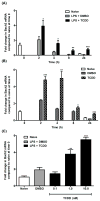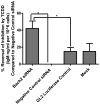Regulation of Bach2 by the aryl hydrocarbon receptor as a mechanism for suppression of B-cell differentiation by 2,3,7,8-tetrachlorodibenzo-p-dioxin
- PMID: 21296099
- PMCID: PMC3106294
- DOI: 10.1016/j.taap.2011.01.020
Regulation of Bach2 by the aryl hydrocarbon receptor as a mechanism for suppression of B-cell differentiation by 2,3,7,8-tetrachlorodibenzo-p-dioxin
Abstract
Exposure to the aryl hydrocarbon receptor (AHR) agonist, 2,3,7,8-tetrachlorodibenzo-p-dioxin (TCDD) alters B-cell differentiation and suppresses antibody production. Previous genomic studies in mouse B cells identified Bach2 as a direct target of the AHR. Bach2 is known to repress expression of Prdm1, a key transcription factor involved in B-cell differentiation, by binding to Maf elements (MAREs) in the regulatory regions of the gene. Chromatin immunoprecipitation followed by quantitative PCR in TCDD-treated lipopolysaccharide (LPS)-activated B cells showed increased binding of the AHR within the first intron in the Bach2 gene. The binding was further confirmed by electrophoretic mobility shift assay (EMSA). TCDD also induced expression of Bach2 in activated as well as resting B cells from 2 to 24h post-treatment in a time- and concentration-dependent manner. Expression of Prdm1 was decreased by TCDD at 24h and was consistent with repression by Bach2. Increased DNA binding activity to the intron 5 MARE with increasing TCDD concentrations was observed by EMSA. Supershifts identified the presence of Bach2 in the DNA binding complex associated with the intron 5 MARE of Prdm1. Functional validation of the role of Bach2 in the suppression of B-cell differentiation by TCDD was performed using RNA interference (RNAi). Knockdown of Bach2 showed approximately 40% reversal in the TCDD-induced suppression of IgM secretion when compared to controls. The results suggest that the transcriptional regulation of Bach2 by the AHR is one of the mechanisms involved in the suppression of B-cell differentiation by TCDD.
Copyright © 2011 Elsevier Inc. All rights reserved.
Conflict of interest statement
Russell S. Thomas acknowledges that he has received grant funding from The Dow Chemical Company for work in a different area.
Figures









Similar articles
-
All-or-none suppression of B cell terminal differentiation by environmental contaminant 2,3,7,8-tetrachlorodibenzo-p-dioxin.Toxicol Appl Pharmacol. 2013 Apr 1;268(1):17-26. doi: 10.1016/j.taap.2013.01.015. Epub 2013 Jan 26. Toxicol Appl Pharmacol. 2013. PMID: 23357550 Free PMC article.
-
Aryl hydrocarbon receptor-dependent suppression by 2,3,7, 8-tetrachlorodibenzo-p-dioxin of IgM secretion in activated B cells.Mol Pharmacol. 1998 Apr;53(4):623-9. Mol Pharmacol. 1998. PMID: 9547351
-
Putative link between transcriptional regulation of IgM expression by 2,3,7,8-tetrachlorodibenzo-p-dioxin and the aryl hydrocarbon receptor/dioxin-responsive enhancer signaling pathway.J Pharmacol Exp Ther. 2000 Nov;295(2):705-16. J Pharmacol Exp Ther. 2000. PMID: 11046109
-
The long winding road toward understanding the molecular mechanisms for B-cell suppression by 2,3,7,8-tetrachlorodibenzo-p-dioxin.Toxicol Sci. 2011 Mar;120 Suppl 1(Suppl 1):S171-91. doi: 10.1093/toxsci/kfq324. Epub 2010 Oct 15. Toxicol Sci. 2011. PMID: 20952503 Free PMC article. Review.
-
Dioxin and immune regulation: emerging role of aryl hydrocarbon receptor in the generation of regulatory T cells.Ann N Y Acad Sci. 2010 Jan;1183:25-37. doi: 10.1111/j.1749-6632.2009.05125.x. Ann N Y Acad Sci. 2010. PMID: 20146706 Free PMC article. Review.
Cited by
-
AhR activation increases IL-2 production by alloreactive CD4+ T cells initiating the differentiation of mucosal-homing Tim3+ Lag3+ Tr1 cells.Eur J Immunol. 2017 Nov;47(11):1989-2001. doi: 10.1002/eji.201747121. Epub 2017 Sep 15. Eur J Immunol. 2017. PMID: 28833046 Free PMC article.
-
Hemolysis inhibits humoral B-cell responses and modulates alloimmunization risk in patients with sickle cell disease.Blood. 2021 Jan 14;137(2):269-280. doi: 10.1182/blood.2020008511. Blood. 2021. PMID: 33152749 Free PMC article.
-
SHP-1 is directly activated by the aryl hydrocarbon receptor and regulates BCL-6 in the presence of 2,3,7,8-tetrachlorodibenzo-p-dioxin (TCDD).Toxicol Appl Pharmacol. 2016 Nov 1;310:41-50. doi: 10.1016/j.taap.2016.08.014. Epub 2016 Aug 18. Toxicol Appl Pharmacol. 2016. PMID: 27546522 Free PMC article.
-
The key player in the pathogenesis of environmental influence of systemic lupus erythematosus: Aryl hydrocarbon receptor.Front Immunol. 2022 Aug 30;13:965941. doi: 10.3389/fimmu.2022.965941. eCollection 2022. Front Immunol. 2022. PMID: 36110860 Free PMC article. Review.
-
Aryl Hydrocarbon Receptor Signaling Is Functional in Immune Cells of Rainbow Trout (Oncorhynchus mykiss).Int J Mol Sci. 2020 Aug 31;21(17):6323. doi: 10.3390/ijms21176323. Int J Mol Sci. 2020. PMID: 32878328 Free PMC article.
References
Publication types
MeSH terms
Substances
Grants and funding
LinkOut - more resources
Full Text Sources

